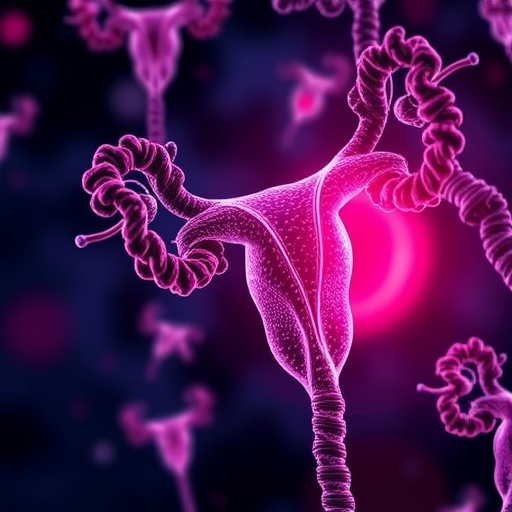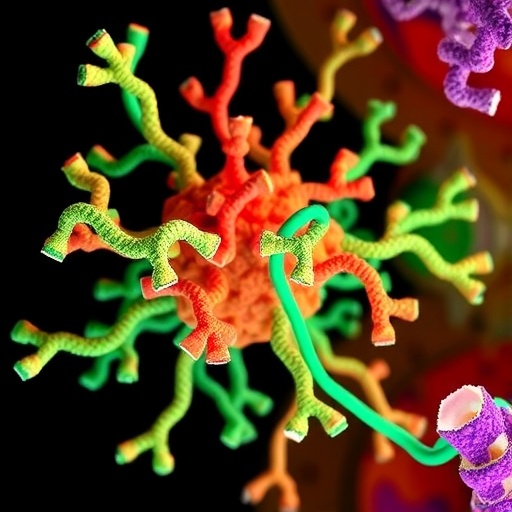In the evolving landscape of cancer research, ovarian cancer poses significant challenges due to its complex biology and late-stage diagnosis, which often leads to poor outcomes. Recent studies have begun to decipher the intricate interplay between cellular mechanisms and patient outcomes, particularly focusing on post-translational modifications (PTMs) of proteins. These modifications, which occur after protein synthesis, are crucial for regulating protein function and stability, thereby impacting cellular processes such as proliferation, apoptosis, and metastasis. The work of Ke and Zhang sheds light on these mechanisms and how they can be therapeutically targeted to improve clinical outcomes for ovarian cancer patients.
The notion that PTMs play a pivotal role in cancer biology is well-established, yet it is the specific implications for ovarian cancer that are beginning to attract significant attention. PTMs include a variety of chemical modifications such as phosphorylation, ubiquitination, glycosylation, and acetylation, each influencing different cellular pathways. For ovarian cancer, these modifications can alter the behavior of tumor cells, granting them the ability to evade apoptosis or acquire resistance to chemotherapeutic agents. By understanding these pathways, researchers hope to identify novel therapeutic strategies that can effectively hinder tumor progression.
In their comprehensive review, Ke and Zhang explore various types of PTMs and their roles in ovarian cancer. Phosphorylation, for instance, is a critical PTM that affects cellular signaling pathways. In ovarian cancer, dysregulated phosphorylation can shift the balance of signaling networks, promoting tumor survival and growth. The authors emphasize the importance of targeting these alterations, suggesting that inhibitors designed to restore normal phosphorylation patterns may yield promising results. This highlights the potential for innovative approaches that could significantly enhance treatment protocols.
Ubiquitination is another focal point of their research that warrants attention. This PTM involves the tagging of proteins for degradation via the proteasome, thereby regulating protein levels within the cell. By manipulating the ubiquitination process, researchers can influence the degradation of oncogenic proteins and stabilize tumor suppressors. Ke and Zhang discuss emerging therapies that aim to modulate ubiquitin pathways, providing a fresh avenue for treatment interventions in ovarian cancer. Such strategies could potentially provide much-needed options for patients who have otherwise limited avenues for effective treatment.
In addition to the established PTMs, the authors delve into the less commonly discussed modifications such as glycosylation and acetylation. These modifications not only affect protein stability and interactions but also contribute to changes in the tumor microenvironment. Glycosylation, for example, can influence immune recognition by masking tumor antigens, thereby facilitating immune evasion. Targeting glycosylation patterns may serve as a strategy to render ovarian tumors more susceptible to immune responses, presenting a new frontier in cancer immunotherapy.
Furthermore, Ke and Zhang address the burgeoning field of clinical applications stemming from basic research into PTMs. As the understanding of these modifications deepens, clinicians are better equipped to utilize this knowledge in designing targeted therapies. The authors advocate for a more personalized approach to ovarian cancer treatment, whereby tumor-specific PTM profiles assist in tailoring therapies that are more effective for individual patients. This strategy could significantly improve treatment outcomes and reduce unnecessary toxicity associated with broad-spectrum chemotherapies.
Interestingly, the implications of targeting PTMs extend beyond direct tumor suppression. The authors also consider the potential for these modifications to be utilized as biomarkers for early detection and prognosis of ovarian cancer. If certain PTMs can be reliably detected in circulating tumor DNA or proteins, they may serve as valuable indicators of disease progression or response to therapy. This bi-directional approach adds an exciting layer to the existing research, merging diagnostic capabilities with therapeutic interventions.
As researchers continue to investigate the underlying mechanisms of PTMs, the interconnectivity with other cellular factors becomes increasingly clear. The authors argue for a broader research agenda that encompasses not only the study of individual PTMs but also their synergistic effects in cancer biology. This holistic view could yield novel insights into the pathways that contribute to ovarian cancer progression and facilitate the development of more comprehensive treatment strategies.
In summary, the work of Ke and Zhang highlights the critical role of post-translational modifications in ovarian cancer, illustrating the intricate mechanisms that underlie tumor biology and resistance. By identifying specific PTMs and developing targeted therapeutic strategies, the researchers provide a blueprint for future studies aiming to improve clinical outcomes for patients with ovarian cancer. As the field progresses, the continued exploration of these modifications offers the promise of groundbreaking advancements in treatment approaches that can ultimately change the trajectory of this challenging disease.
The features of this emerging research spotlight the urgency of advancing our understanding and treatment of ovarian cancer through novel interventions. With ovarian cancer remaining one of the most lethal gynecological malignancies, the need for innovative therapies has never been more critical. The focus on post-translational modifications not only presents a new horizon in understanding cancer mechanisms but also sparks hope for transformative clinical applications that could benefit countless patients in the years to come.
The strides made in this domain symbolize a significant leap toward personalized medicine, where tumor biology is intricately linked with therapy design. As researchers continue to unveil the complexities of ovarian cancer, the integration of such cutting-edge approaches could usher in a new era of effective and targeted treatment options, ultimately leading to better patient prognoses and survival rates.
In conclusion, the exploration of therapeutic targeting of post-translational modifications presents a beacon of hope in the fight against ovarian cancer. Continued research in this area is essential for uncovering the nuances of tumor biology and for developing interventions that may significantly improve patient outcomes. As we stand at the cusp of these promising scientific advancements, the potential for transformative change in ovarian cancer treatment remains tantalizingly within reach.
Subject of Research: Post-Translational Modifications in Ovarian Cancer
Article Title: Therapeutic targeting of post-translational modifications in ovarian cancer: mechanisms and clinical applications
Article References:
Ke, L., Zhang, Y. Therapeutic targeting of post-translational modifications in ovarian cancer: mechanisms and clinical applications.
J Ovarian Res 18, 251 (2025). https://doi.org/10.1186/s13048-025-01833-w
Image Credits: AI Generated
DOI: https://doi.org/10.1186/s13048-025-01833-w
Keywords: Post-Translational Modifications, Ovarian Cancer, Therapeutic Targeting, Cancer Biology, Clinical Applications.
Tags: apoptosis evasion in ovarian cancerclinical outcomes in ovarian cancerglycosylation effects on tumorsmetastatic processes in ovarian cancernovel therapeutic strategies for ovarian cancerovarian cancer biology and treatmentpost-translational modifications in ovarian cancerprotein modifications and cancerprotein stability and function in cancerrole of phosphorylation in cancertherapeutic targeting of PTMstumor cell resistance mechanisms





